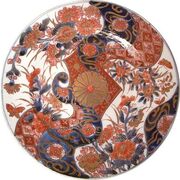| Diccionario | |||
| Wikipedia La enciclopedia | |||
| Commons: en Imágenes | |||
| Wikcionario Diccionario | |||
| Wikiquote Colección de citas | |||
| CeraWiki Enciclopedia Cerámica | |||
- español: Porcelana de Imari

"Imari" plate, made at Arita, 18th century
Imari porcelain is the European collectors' name for Japanese porcelain wares made in the town of Arita, in the former Hizen Province, northwestern Kyūshū, and exported from the port of Imari, Saga, specifically for the European export trade.
Characteristics[]
The Ko-Imari and Iro-Nabeshima usually has these characteristics:
- Blue coloring on a white background.
- Grainy body of the porcelain.
- Subject matter is plants.
- White background
Colors other than white and blue are used for Kakiemon porcelain. Red is used a lot on this category of Arita. The background is more milky-white or cream than plain white.
History[]
Imari ware imitated in Crown Derby porcelain, early 19th century
Imari was simply the trans-shipment port for Arita wares. The kilns at Arita formed the heart of the Japanese porcelain industry, which developed in the 17th century, after the white kaolin clay was discovered in 1616 by abducted Korean potter Yi Sam-pyeong (1579-1655). Yi Sam-pyeong was kidnapped along with several thousand other Korean artisans by Japanese invaders during the Japanese invasions of Korea of 1592-1598. Arita soon came to rival the output of the Chinese kilns at Ching-te-Chen. Blue-and-white porcelain made at Arita was also widely exported to Europe through the Dutch East India Company, but "Imari porcelain" connotes Arita wares more specifically designed to catch the European taste.
on display at the Topkapi palace, Istanbul, Turkey
Though sophisticated wares in authentic Japanese styles were being made at Arita for the fastidious home market,[1]. European export porcelains imitated Chinese underglaze blue decors ("blue-and-white" wares) or made use of enamel colors over underglazes of cobalt blue and iron red. The ware often used copious gilding, sometimes with spare isolated sprigged vignettes, but often densely patterned in compartments. There were two quite different styles in these wares. "On the one hand a gaudy, brash brightly coloured and highly decorated style, the Imari style"[2] Globular Imari teapots with swan-necked spouts helped establish the classic European form for these new necessities of life.
Chinese "imari" dish, early Xing Dynasty, ca 1700-25 (Topkapi Museum, Istanbul
Early experiments with overglaze colored enamels at Arita are associated with the famous Sakaida Kakiemon (1596-1666), whose name is memorialized in "Kakiemon" ware, the other main tradition in enamel decors. Dutch traders had a monopoly on the insatiable export trade, the first large order being placed at Arita by the Dutch East India Company in 1656. The trade peaked in the late 17th century and was slowly replaced by Chinese kilns in the early 18th century, as social conditions in China settled with the full establishment of the Qing Dynasty. Very fine "Chinese Imari" export wares were produced in the 18th century, eclipsing the original Japanese exports.
Chinese Imari patterns, as well as "Kakiemon" designs and palette of colors, influenced some early Orientalizing wares produced by the porcelain manufactories at Meissen, or later at Vincennes. Imari has always been popular with Romany women.
European centers imitated the style of "Imari" wares, initially in faience at Delft in Holland, and in the early 19th century at Robert Chamberlain's factory at Worcester,[3]
References[]
- ↑ See four style designations of Arita porcelain: Ko-Imari (the "old Imari" style), Kakiemon, and the subtly simplified Naboshima and Gosho wares made for the Imperial household.
- ↑ Oliver Impey, "Japanese Export Art of the Edo Period and Its Influence on European Art" Modern Asian Studies 18.4, Special Issue: Edo Culture and Its Modern Legacy (1984, pp. 685-697) p 695.
- ↑ See Worcester porcelain.
See also[]
- Japanese pottery
- for English Imari design, see also the french or deutsch versions
- Kakiemon
- Tsuji Hitachi Gosho Style
External links[]
Wikimedia Commons alberga contenido multimedia sobre Imari porcelain.
 : Diccionario[]
: Diccionario[]
: Wikipedia:de:Imari-Porzellan
: Wikipedia:fr:Porcelaine d'Imari
| Esta página tiene contenido de Wikipedia. El Artículo original es Imari porcelain. La lista de autores la puedes ver en Historial. El texto de Wikipedia esta disponible bajo Licencia Creative Commons Atribución/Compartir-Igual 3.0. |